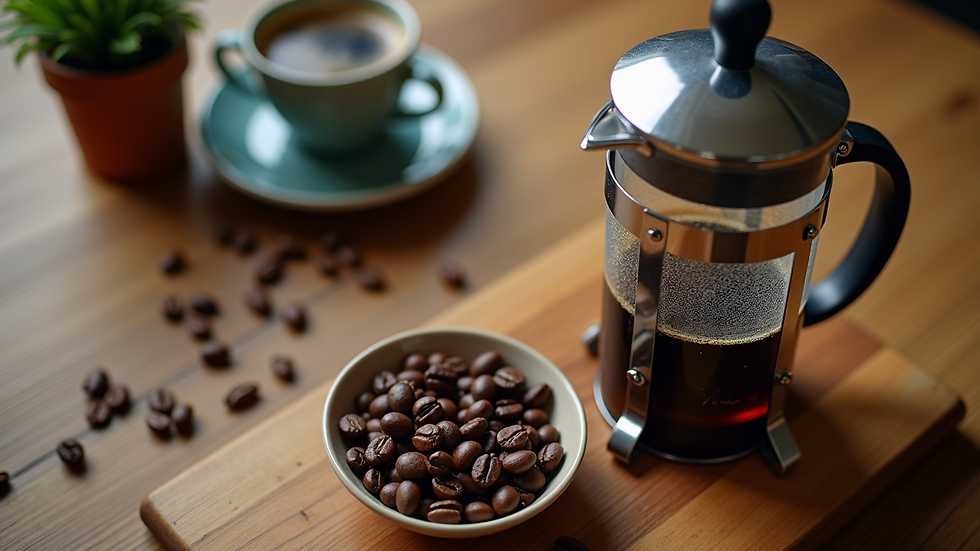Exploring the World of Coffee: Types, Flavors, and Brewing Tips
- TS Vensava

- Sep 15
- 4 min read
Coffee is more than just a morning ritual; it is a rich and diverse world filled with unique flavors, brewing methods, and cultural traditions. Whether you are a casual drinker or an aspiring barista, understanding the different types of coffee and how to brew them can elevate your experience. This guide will take you through the most popular types of coffee, their flavor profiles, and practical brewing tips to help you enjoy every cup to the fullest.
Understanding the Different Types of Coffee Beans
The foundation of any great cup starts with the beans. There are four main types of coffee beans, each with distinct characteristics:
Arabica: Known for its smooth, complex flavor and aromatic qualities. Arabica beans are grown at higher altitudes and tend to have a sweeter, softer taste with hints of fruit and sugar.
Robusta: These beans have a stronger, more bitter flavor and contain more caffeine. They are often used in espresso blends for added body and crema.
Liberica: Less common, Liberica beans have a unique smoky and floral aroma with a somewhat woody taste.
Excelsa: Often used to provide tart, fruity notes in blends, Excelsa beans have a mysterious flavor profile that can range from dark and mysterious to light and fruity.
Choosing the right bean depends on your flavor preference and brewing method. For example, Arabica is excellent for drip coffee, while Robusta works well in espresso.

Popular Types of Coffee Drinks and Their Flavors
Coffee drinks vary widely around the world, but some classics stand out for their unique preparation and taste:
Espresso
A concentrated shot of coffee made by forcing hot water through finely-ground beans. It has a rich, bold flavor and a creamy layer called crema on top.
Americano
Made by adding hot water to an espresso shot, resulting in a lighter, more diluted flavor similar to drip coffee.
Latte
Espresso combined with steamed milk and a small layer of foam. It’s creamy and mild, often flavored with syrups like vanilla or caramel.
Cappuccino
Similar to a latte but with equal parts espresso, steamed milk, and foam, giving it a frothier texture and stronger coffee taste.
Cold Brew
Coffee steeped in cold water for 12-24 hours, producing a smooth, less acidic, and refreshing drink.
Macchiato
An espresso "stained" with a small amount of milk foam, offering a strong coffee flavor with a hint of creaminess.
Each of these drinks highlights different aspects of the beans’ flavor, from bold and intense to smooth and creamy.

What is the 80/20 Rule for Coffee?
The 80/20 rule, also known as the Pareto Principle, can be applied to coffee brewing to maximize enjoyment with minimal effort. It suggests that 80% of your coffee’s flavor comes from 20% of the brewing process. This means focusing on the most impactful factors can dramatically improve your cup without overcomplicating things.
Key elements to focus on include:
Freshness of beans: Use freshly roasted and ground beans for the best flavor.
Water quality and temperature: Use clean, filtered water heated to about 195-205°F.
Grind size: Match the grind size to your brewing method (coarse for French press, fine for espresso).
Brewing time: Avoid over-extraction by timing your brew correctly.
By mastering these basics, you can enjoy a consistently great cup without needing to obsess over every detail.

Brewing Tips for the Perfect Cup
Brewing coffee is both an art and a science. Here are some practical tips to help you get the most out of your beans:
Measure your coffee and water: A general guideline is 1 to 2 tablespoons of coffee per 6 ounces of water. Adjust to taste.
Grind just before brewing: Grinding releases the coffee’s aroma and flavor but also causes it to lose freshness quickly.
Use the right equipment: Whether it’s a drip machine, French press, or espresso maker, each method requires specific grind sizes and techniques.
Control water temperature: Too hot water can burn the coffee, while too cold water under-extracts it.
Experiment with brew time: For example, French press coffee usually steeps for 4 minutes, while espresso shots take about 25-30 seconds.
Clean your equipment regularly: Residue can affect the taste of your coffee.
Try different methods and beans to discover what suits your palate best. Keeping a brewing journal can help track what works and what doesn’t.
Exploring Coffee Flavors Around the World
Coffee culture varies globally, and so do the flavors and preparation styles. Here are some notable examples:
Italian Coffee: Known for espresso and cappuccino, Italians emphasize strong, concentrated coffee with creamy textures.
Turkish Coffee: Finely ground coffee simmered with water and sugar, served unfiltered for a thick, intense experience.
Ethiopian Coffee: Often brewed using a traditional jebena pot, Ethiopian coffee is fruity and floral, reflecting its origin as the birthplace of coffee.
Vietnamese Coffee: Strong coffee brewed with a drip filter and served over sweetened condensed milk, often iced.
Swedish Fika: A social coffee break featuring light roasted coffee paired with pastries.
Exploring these styles can deepen your appreciation for the diversity of coffee and inspire you to try new flavors and techniques.
Whether you are brewing a simple cup at home or exploring specialty drinks, understanding the types of coffee and how to prepare them can transform your daily routine into a delightful experience. For more insights and quality beans, visit Cafe Vensava and start your journey into the world of coffee today!




Comments